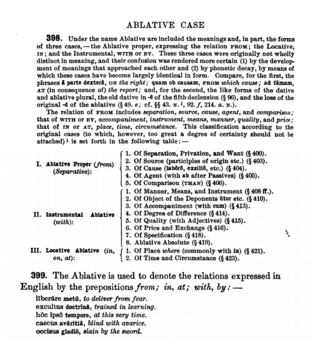Related Research Articles
The accusative case of a noun is the grammatical case used to receive the direct object of a transitive verb.

In grammar, the ablative case is a grammatical case for nouns, pronouns, and adjectives in the grammars of various languages; it is sometimes used to express motion away from something, among other uses. The word "ablative" derives from the Latin ablatus, the (irregular) perfect, passive participle of auferre "to carry away".
A grammatical case is a category of nouns and noun modifiers which corresponds to one or more potential grammatical functions for a nominal group in a wording. In various languages, nominal groups consisting of a noun and its modifiers belong to one of a few such categories. For instance, in English, one says I see them and they see me: the nominative pronouns I/they represent the perceiver and the accusative pronouns me/them represent the phenomenon perceived. Here, nominative and accusative are cases, that is, categories of pronouns corresponding to the functions they have in representation.

Hungarian is a Uralic language spoken in Hungary and parts of several neighbouring countries that used to belong to it. It is the official language of Hungary and one of the 24 official languages of the European Union. Outside Hungary, it is also spoken by Hungarian communities in southern Slovakia, western Ukraine (Subcarpathia), central and western Romania (Transylvania), northern Serbia (Vojvodina), northern Croatia, northeastern Slovenia (Prekmurje), and eastern Austria.
In grammar, the inessive case is a locative grammatical case. This case carries the basic meaning of "in": for example, "in the house" is talo·ssa in Finnish, maja·s in Estonian, куд·са in Moksha, etxea·n in Basque, nam·e in Lithuanian, sāt·ā in Latgalian and ház·ban in Hungarian.
In grammar, the elative case is a locative grammatical case signifying that something comes from something, somewhere or someone.
In grammar, the illative case is a grammatical case used in the Finnish, Estonian, Lithuanian, Latvian and Hungarian languages. It is one of the locative cases, and has the basic meaning of "into ". An example from Hungarian is a házba. An example from Estonian is majasse and majja, formed from maja ('house'). An example from Finnish is taloon, formed from talo, another from Lithuanian is laivan formed from laivas ('boat'), and from Latvian laivā formed from laiva ('boat').
In grammar, an adessive case is a grammatical case generally denoting location at, upon, or adjacent to the referent of the noun; the term is most frequently used in Uralic studies. In Uralic languages, such as Finnish, Estonian and Hungarian, it is the fourth of the locative cases with the basic meaning of "on"—for example, Estonian laud (table) and laual, Hungarian asztal and asztalnál. It is also used as an instrumental case in Finnish.
In grammar, the allative case is a type of locative grammatical case. The term allative is generally used for the lative case in the majority of languages that do not make finer distinctions.
In grammar, the essive case, or similaris case, is a grammatical case. The essive case on a noun can express it as a definite period of time during which something happens or during which a continuous action was completed. It can also denote a form as a temporary location, state of being, or character in which the subject was at a given time. The latter meaning is often described as the equivalent of the English phrase "as a __".
In linguistics, abessive, caritive and privative is the grammatical case expressing the lack or absence of the marked noun. In English, the corresponding function is expressed by the preposition without or by the suffix -less.
The Finnish language is spoken by the majority of the population in Finland and by ethnic Finns elsewhere. Unlike the languages spoken in neighbouring countries, such as Swedish and Norwegian, which are North Germanic languages, or Russian, which is a Slavic language, Finnish is a Uralic language of the Finnic languages group. Typologically, Finnish is agglutinative. As in some other Uralic languages, Finnish has vowel harmony, and like other Finnic languages, it has consonant gradation.
Fusional languages or inflected languages are a type of synthetic language, distinguished from agglutinative languages by their tendency to use a single inflectional morpheme to denote multiple grammatical, syntactic, or semantic features.
In grammar, the instrumental case is a grammatical case used to indicate that a noun is the instrument or means by or with which the subject achieves or accomplishes an action. The noun may be either a physical object or an abstract concept.
The distributive-temporal of a noun is a grammatical case specifying when and how often something is done.
In linguistics, a possessive affix is an affix attached to a noun to indicate its possessor, much in the manner of possessive adjectives.
Hungarian grammar is the grammar of Hungarian, a Finno-Ugric language that is spoken mainly in Hungary and in parts of its seven neighboring countries.
The multiplicative case is a grammatical case used for marking a number of something.
This article deals with the grammar of the Udmurt language.
This article deals with the grammar of the Komi language of the northeastern European part of Russia
References
- ↑ Mäkinen, Panu. "Finnish Grammar - Adverbial Cases". users.jyu.fi. University of Jyväskylä. Retrieved 6 March 2015.